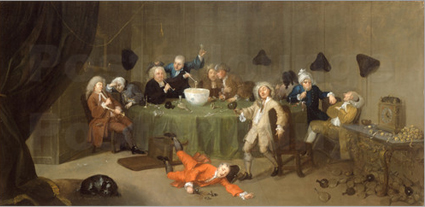To mark the anniversary of the founding of Alcoholics Anonymous (albeit in somewhat woozy style) today’s picture is a cautionary visual demonstration of the perils of booze. Its title is A Midnight Modern Conversation; its subject is a Georgian drinking party in full swing; and it was painted by William Hogarth in about 1730.
This vigorous and unruly picture marked a turning point in the artist’s early career. Up until the late 1720s the young Hogarth had principally concentrated on establishing himself as a painter of portraits. His speciality had been the well established genre of the “conversation picture”, in which members of the gentry or aristocracy are shown sipping tea and complacently chatting among themselves. Hogarth had injected his own brand of robust vitality into this stiflingly conventional art form by introducing wild pets and mischievous children who threaten to upset teatables, knock over ornaments or otherwise cause disturbance. Such forcefully unconventional portraiture impressed his contemporaries but left the more perceptive among them suspecting that Hogarth’s true vocation lay elsewhere. Horace Walpole thought face-painting was perhaps “the most ill-suited employment imaginable to a man whose turn was certainly not flattery, nor his talent adapted to look on vanity without a sneer.”
A Midnight Modern Conversation proved Walpole’s point and set Hogarth on the road to both fame and (by the standard of most eighteenth-century English painters’ incomes) fortune. As its title suggests, the artist looked back to the tradition of the conversation picture when he painted A Midnight Modern Conversation. But he did so only to turn that tradition on its head – almost literally, in the case of the sprawling figure centre stage – and in so doing created a new kind of topical, comic English art. The painting is, so to speak, an anti-conversation picture,...


